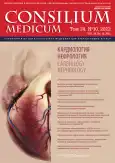The prevalence of hypertension among patients with psoriasis in clinical practice
- Authors: Kuzmina O.A.1, Mironova O.I.1, Lepekhova A.A.1, Fomin V.V.1
-
Affiliations:
- Sechenov First Moscow State Medical University (Sechenov University)
- Issue: Vol 24, No 10 (2022)
- Pages: 763-766
- Section: Articles
- URL: https://journals.rcsi.science/2075-1753/article/view/120394
- DOI: https://doi.org/10.26442/20751753.2022.10.201926
- ID: 120394
Cite item
Full Text
Abstract
Background. Psoriasis is a systemic chronic immune-mediated inflammatory skin disease of a multifactorial nature that affects about 2 to 3% of the population worldwide. Given the systemic nature of the disease, the level of comorbid diseases is high, especially those associated with damage to the cardiovascular system. According to the results of various meta-analyzes, it has been proven that among patients with psoriasis, the risk of developing hypertension is high.
Aim. To evaluate the prevalence of arterial hypertension (AH) among patients with psoriasis.
Materials and methods. We present an open, prospective, observational clinical trial, which includes 60 patients diagnosed with psoriasis vulgaris of varying severity and psoriatic arthritis. All patients underwent clinical and laboratory tests, including the level of total cholesterol, glucose, creatinine, C-reactive protein, calculation of glomerular filtration rate. Body mass index, blood pressure level according to the Korotkov method, severity of the disease by determining psoriasis area and severity Index (PASI), dermatological quality of life index (DLQI), levels of hospital anxiety and depression according to the HADS scale were also assessed. The SCORE2 scale was used to assess cardiovascular risk in patients aged 40 to 69 years, the SCORE 2OP scale for patients aged 70 to 89 years, respectively. Cardiovascular risk was defined as low for patients under 40 years of age. All study participants were examined for the presence of AH.
Results. The prevalence of hypertension was 25%, with prevalence among men (15%). The prevalence of hypertension is directly proportional to the severity of psoriasis (13% with hypertension in patients with severe psoriasis, 12% with hypertension with moderate psoriasis, 2% with hypertension with mild psoriasis).
Conclusion. Given the high prevalence of AH among patients with psoriasis, it is necessary to form a multidisciplinary approach to the treatment of patients, including a thorough assessment of cardiovascular risk in clinical practice.
Full Text
##article.viewOnOriginalSite##About the authors
Olga A. Kuzmina
Sechenov First Moscow State Medical University (Sechenov University)
Author for correspondence.
Email: olga.dm.ru@mail.ru
ORCID iD: 0000-0001-9240-9513
Graduate Student, Sechenov First Moscow State Medical University (Sechenov University)
Russian Federation, MoscowOlga Iu. Mironova
Sechenov First Moscow State Medical University (Sechenov University)
Email: mironova_o_yu@staff.sechenov.ru
ORCID iD: 0000-0002-5820-1759
D. Sci. (Med.), Sechenov First Moscow State Medical University (Sechenov University)
Russian Federation, MoscowAnfisa A. Lepekhova
Sechenov First Moscow State Medical University (Sechenov University)
Email: lepekhova_a_a@staff.sechenov.ru
ORCID iD: 0000-0002-4365-3090
Cand. Sci. (Med.), Sechenov First Moscow State Medical University (Sechenov University)
Russian Federation, MoscowVictor V. Fomin
Sechenov First Moscow State Medical University (Sechenov University)
Email: olga.dm.ru@mail.ru
ORCID iD: 0000-0002-2682-4417
D. Sci. (Med.), Prof., Corr. Memb. RAS, Sechenov First Moscow State Medical University (Sechenov University)
Russian Federation, MoscowReferences
- Parisi R, Iskandar IYK, Kontopantelis E, et al. National, regional, and worldwide epidemiology of psoriasis: systematic analysis and modelling study on behalf of the Global Psoriasis Atlas. BMJ. 2020;369:m1590. doi: 10.1136/bmj.m1590
- Iskandar Id IYK, Parisi R, Griffiths CEM, et al. Systematic review examining changes over time and variation in the incidence and prevalence of psoriasis by age and gender*. Br J Dermatol. 2021;184(2):243-58. doi: 10.1111/bjd.19169
- Andújar I, Esplugues JV, García-Martínez P. Looking beyond the Skin: Pathophysiology of Cardiovascular Comorbidity in Psoriasis and the Protective Role of Biologics. Pharmaceuticals. 2022;15:1-18. doi: 10.3390/ph15091101
- Toussirot E, Gallais-Sérézal I, Aubin F. The cardiometabolic conditions of psoriatic disease. Front Immunol. 2022;13:1-9. doi: 10.3389/fimmu.2022.970371
- Yamazaki F. Psoriasis: Comorbidities. J Dermatol. 2021;48(6):732-40. doi: 10.1111/1346-8138.15840
- Rendon A, Schäkel K. Psoriasis Pathogenesis and Treatment. Int J Mol Sci. 2019;20:1475. doi: 10.3390/ijms20061475
- Kanda N. Molecular Sciences Psoriasis: Pathogenesis, Comorbidities, and Therapy Updated. Int J Mol Sci. 2021;22(6):2979. doi: 10.3390/ijms22062979
- Plénkowska J, Gabig-Cimí Nska M, Mozolewski P. Molecular Sciences Oxidative Stress as an Important Contributor to the Pathogenesis of Psoriasis. Int J Mol Sci. 2020;21(17):6206. doi: 10.3390/ijms21176206
- Garshick MS, Ward NL, Krueger JG, et al. Cardiovascular Risk in Patients With Psoriasis: JACC Review Topic of the Week. J Am Coll Cardiol. 2021;77:1670-80. doi: 10.1016/J.JACC.2021.02.009
- Liu L, Cui S, Liu M, et al. Psoriasis Increased the Risk of Adverse Cardiovascular Outcomes: A New Systematic Review and Meta-Analysis of Cohort Study. Front Cardiovasc Med. 2022;9:1-12. doi: 10.3389/fcvm.2022.829709
- Duan X, Liu J, Mu Y, et al. A systematic review and meta-analysis of the association between psoriasis and hypertension with adjustment for covariates. Medicine (United States). 2020;99. doi: 10.1097/MD.0000000000019303
- Takeshita J, Wang S, Shin DB, et al. Effect of psoriasis severity on hypertension control: a population-based study in the United Kingdom. JAMA Dermatol. 2015;151:161-9. doi: 10.1001/JAMADERMATOL.2014.2094








